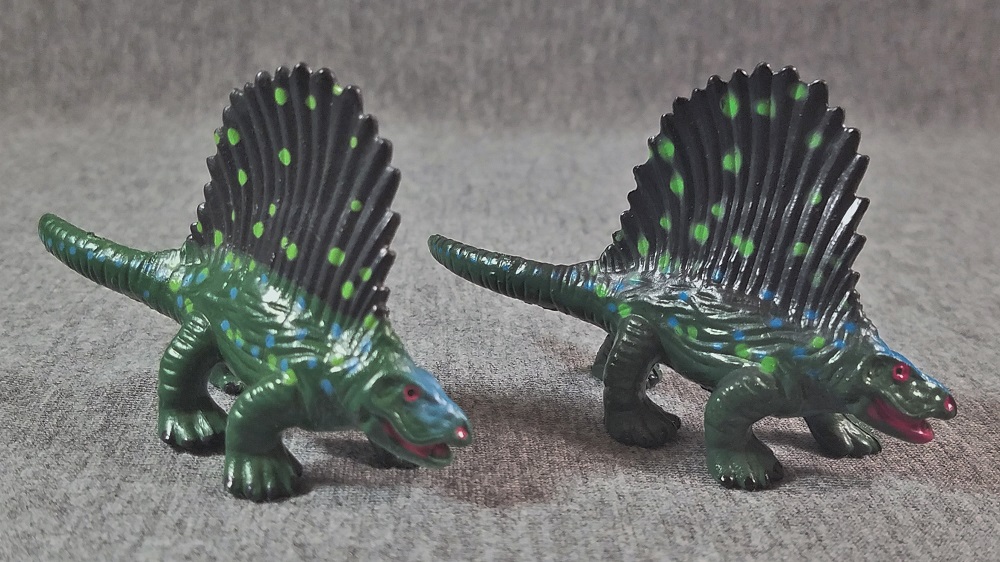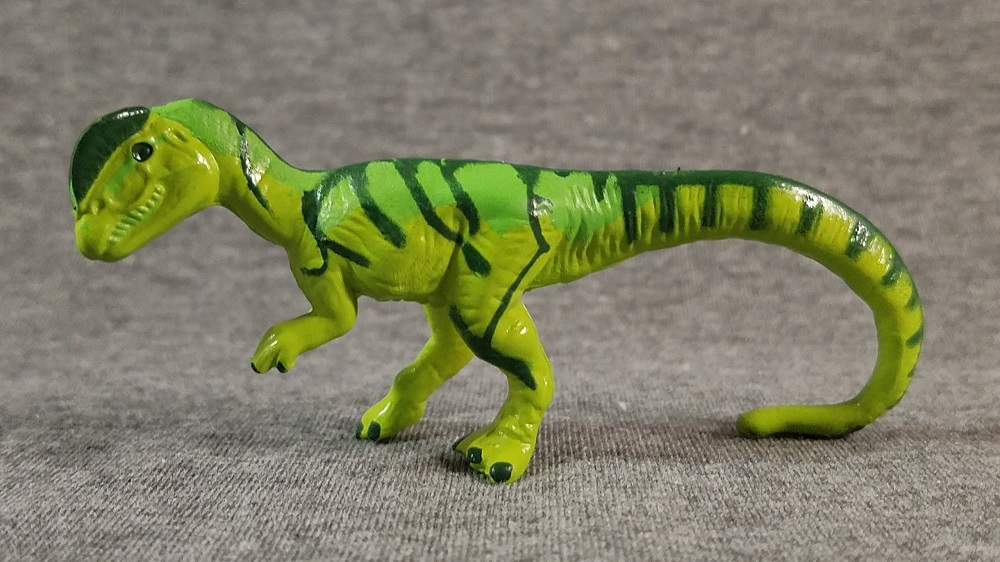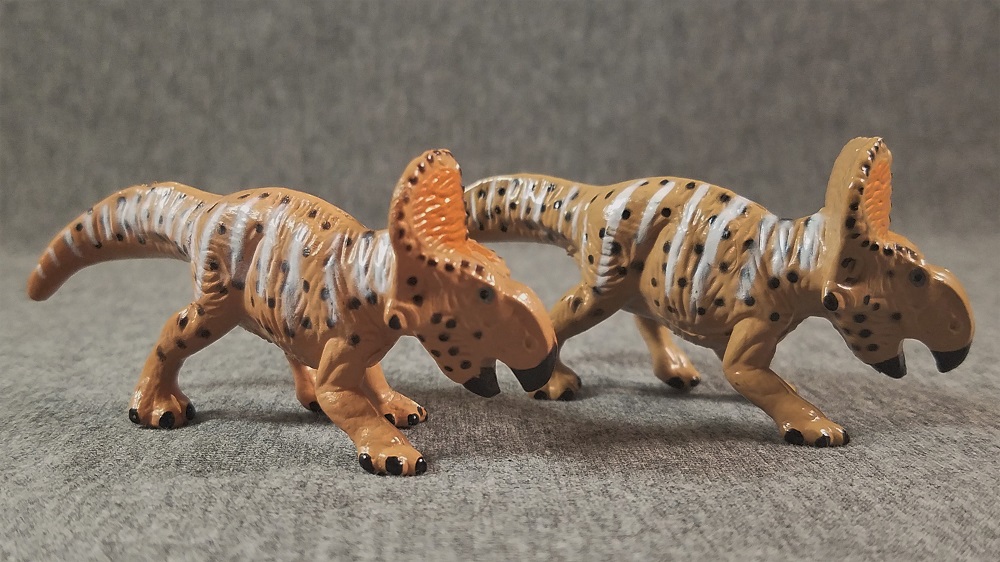This fine set of little Battat precursors from Gregory Wenzel has aged impressively well, and any collector who’s found a chance to own the set should find these a delight.
Back in the 1990s, Safari ltd. was still a bold newcomer on the collectibles stage; with their success on the Carnegie Collection line, the company began exploring additional means to grow their brand. The first results of Safari’s expansion to see release and sale were the Authentics Habitats Collections, series of themed minifigures based on environments or broad animal groups. A total of three sets were dedicated to dinosaurs and other prehistoric creatures, which were evidently successful enough to remain in production through various re-brands and variations until the mid-2000s. Each set had a unique sculptor in charge. The first Dino set was sculpted by Forest Rogers, who was also in charge of the main Carnegie Collection models. The 2nd & 3rd sets would see brand new talent enter the fray under Safari’s banner.

The Dinosaurs II set was handled by sculptor Gregory Wenzel, a sculptor and illustrator who would become more famous in the following years when he began working for Battat to produce sculpts for the Boston Museum dinosaur line. Like the first set, six original dinosaur minifigures were featured. Each dinosaur is vaguely uniform in size, measuring roughly 7 cm (3 in) long; unsurprisingly they are not all to scale with each other. Unlike the first set, however, Wenzel’s designs lean much more into a semi-realistic aesthetic, instead of Roger’s more stylized “retro” look.


Although I said the Dinosaurs II Authentics set features six dinosaurs, that technically wasn’t true: Dimetrodon is often mistaken for a dinosaur, but is in fact an older creature hailing from the synapsids, the group which mammals would eventually emerge. Ranging from 1:23 to 1:60 scale, depending on the species, Dimetrodon is the first non-dinosaur featured in the three dino sets Safari released, although it would not be the last. With legs and body raised, spread mid-stride, Greg Wenzel’s take on the sailed synapsid looks a little more modern than many depictions even in years following; this looks like an active creature drawing upon as much mammal as it is large-bodied reptile. A slightly stylized, shorter tail further emphasizes the mammalian traits over the reptilian, and the face has an almost jowly appearance to the distinctive skull which further blends the two. In contrast, the color scheme of bright green and blue polka-dots seems almost amphibian in appearance, but at least it’s eye-catching. Texturing is mostly smooth with some striations here and there; the impressive sail has each spine distinctly shaped, however.

The Safari Authentics would see multiple releases and re-releases over the years, with subtle differences between them. There are two Dimetrodon figurines in my collection, one with the Safari ltd. logo and other basic copyright information engraved on the belly, and the other with only “CHINA” printed underneath. The second version is also made of harder plastic, and has a slightly glossier finish. Coloration on the second version is generally darker, and the paint application to facial details is sloppier. There is a known set of bootlegged Authentics which was produced by Colorata in 2004 and included Dimetrodon along with other set 2 minifigures; however these were painted very differently and should be immediately distinguishable.

Moving on to the true dinosaurs we have Dilophosaurus, a personal favorite of mine. The Dilophosaurus was my first-ever Toob figurine from Safari ltd., so it was of special interest to discover that the Toob version was a direct rescale of the Authentics toy. Wenzel’s original sculpt is longer than the Toob successor, and in fact longer than most of the other Authentics toys in this set, measuring 8 cm (3.25 in) even before the curve of the tail – in the ballpark of 1:75 scale . Even with somewhat stylized proportions, this toy depicts a very limber and gracile predator, with long legs and a fierce visage of a skull built to bring down prey with strength and skill. The arms are modestly sized, but the hands go to the trouble of featuring all four fingers, even if the fourth finger might not have been visible in real life. The signature “snarl” shape of the skull is well-defined, although a bit shrink-wrapped to emphasize the facial features. The iconic crests are also prominently displayed, of course; although the popularly-depicted pointy flange in the back is absent.


Dilophosaurus is arrayed in vibrant green hues, with dark striping and highlights to the digits, eyes, and crests. Coloration will vary between versions; I have a second copy with a duller base coat but more saturated second coat, emphasizing the face and back more. This second copy is also made of a softer plastic, and once again is marked only with “China” on its belly. I’ve also seen photos of an entirely different original color scheme for this toy, which was light yellowish-green in base with red spots and stripes and highlights. I suspect this color scheme was replaced early on in production runs, since I’ve never seen one listed for sale; so it might be a rarer version today. This is pure speculation, though; more information on this change would be ideal.

Euoplocephalus was a regularly featured dinosaur in many of the books I grew up with, but relatively few figures of the genus have been produced – not counting toys labeled as Ankylosaurus which were based more on Euoplocephalus remains, at least. Although looking a bit dated now, the Authentics figurine is probably one of the better renditions even today, at only about 1:70 scale. There’s a good sense of weight and volume to the figurine, even at its small size. The body isn’t as wide as modern reconstructions, but does feature the barrel shape typical for the time period. All the armor arrangements also match standard reconstructions, plus the distinctive double-knob tail club. There is nice skin texture under the body, and the head and limbs have good proportions. Only the feet look obviously exaggerated for the size of the toy.

Coloration between versions of Euoplocephalus can differ a little more drastically than the other figurines in the set. The armored dino is painted a dull green on top with an orange/yellow wash on its flanks and underside. The face and digits are highlighted in black, and the individual armor scutes are a creamy off-white. A second copy in my possession, again with softer plastic and less labeling, is much darker and more saturated in color, with more pronounced red and yellow patches of skin and purer white armor. Either way, this is a good-quality representation of a semi-famous ankylosaur for its time. Ironically, when the Authentics Euoplocephalus would end up repurposed for Safari’s Dinos Toob, it would be relabeled as Ankylosaurus.

Not every mold from set 2 would see a second life as a Toob minifigure – which is almost a shame, because Gregory Wenzel’s Authentics Protoceratops quite the handsome little figure. There are actually a few different Protoceratops toys produced since the 90s which are quite good, including miniatures from Colorata, Kaiyodo, Wild Past, and a brand-new version by Safari ltd themselves; but Wenzel’s sculpt still holds up extremely well. Ranging between 1:33-1:24 scale, the skeletal proportions of Protoceratops translate well into miniature, from the giant frilled head to the short, flattened tail. Although somewhat glossy and smooth-looking at a glance, like the rest of the set, the sculpt does have a nice amount of striated skin texture. There’s even wrinkly/scaly texture on the front and back of the frill. This is probably one of the Authentics figurines which has aged the very best, and I can see why some collectors find this one particularly desirable.

Although plastic softness can vary between releases, as usual, coloration on the Protoceratops seems to remain more consistent. Both figurines in my collection – and those I’ve seen up for sale elsewhere – are a light orangey-tan in coloration, with black polka-dots and vertical white stripes breaking up the silhouette and creating a striking profile with very minimal color range. More saturated orange is found on the front of the frill, reasonable for display purposes. Upon close inspection there is also a lightly faded underbelly closer to white. Despite more basic hues, this is a very attractive scheme overall, complementing the more vibrant figurines in this set nicely.

Another splendid figure from this set which never saw a Toob resurrection is the Styracosaurus – another ceratopsian from Greg Wenzel. Like its smaller relative, the Styracosaurus appears to follow skeletal proportions very closely – although perhaps this one is a little bit long in the body and tail. This is arguably the largest figure in the set, matching the Dilophosaurus’s 8 cm (3 in) length but with much more body mass, around the ballpark of 1:70 scale. Wenzel’s miniature work here feels a little extra prescient, since Styracosaurus was among the genera Wenzel would go on to produce at a larger scale for the Battat Museum line (and with similar coloration and posing). This is an animal designed with size and strength, but also grace to its form – a real renaissance dinosaur. Ceratopsian reconstructions haven’t changed TOO much since the 90s, so once again this figurine has ended up aging well.


In contrast to Protoceratops’s plain colors but striking patterns, Styracosaurus has simpler patterns but richer colors. The spiked herbivore is depicted in deep blues, with a row of red-orange stripes down the back, plus the same highlights to the mouth and eyes. The horns are a simple light gray, but at their size they stand out fine without more color. Saturation of hues might vary between copies; my second copy also features a darker reddish spray on the stomach and the tail’s underside. It’s another eye-pleasing color scheme that’s more subdued than the theropods of the set.

Speaking of said theropods, Velociraptor rounds out the set in a sprightly pose with tail straight out and arms forward. Although the figurine is technically tripod-posed, the angle and overall feel of the model is of a creature light on its feet and caught mid-bounce. Happily evading (preceding?) the blocky Deinonychus-inspired skull shape of the Jurassic Park raptors, this 1:25/1:20-scaled Velociraptor is built slender and sleek, in great contrast to the hefty ceratopsians of the set. No feathers are featured on this model, but sculpting feathers at this scale might have been a bit more of a challenge than Wenzel was ready to tackle – and maybe a bit more progressive than Safari or its retailers were comfortable endorsing yet.

Velociraptor’s color scheme provides great contrast to both Protoceratops, with its simpler hues, and fellow theropod Dilophosaurus, with its cooler color range, by sporting aggressive red tiger stripes over a vibrant yellow and orange body. Even without feathers, this little dino is clearly born of a scientific age which had discarded the notion of slow-and-sluggish Mesozoic dullards. Coloration is very consistent between figurines as well, at least from what I’ve seen. Apart from some slightly less sharp application to the eyes and the stripes, my two “speedy thieves” are almost indistinguishable without reading the engravings on their bellies.

Not long after the release of the Authentics set, the Boston Museum of Natural History would hire Gregory Wenzel (as well as Dan LoRusso) to sculpt a brand new set of medium-to-large dinosaur figures under the toy company Battat. It’s somewhat ironic to see how Wenzel cut his teeth under Safari ltd before going on to help produce their first (and one of their greatest, by history’s mark) competing toy lines. The Authentics Dinos, set 2 is a fine little collection of dinosaurs to this day, and any avid collector should be able to feel a bit proud if they own this set. Although the Authentics Habitats line is now discontinued, vigilant collectors should be able to still obtain these from eBay, Mercari, or other online marketplaces for affordable prices.

[edited 2025/02/09 for individual model scaling]
Disclaimer: links to Ebay and Amazon on the DinoToyBlog are affiliate links, so we make a small commission if you use them. Thanks for supporting us!




Scolosaurus, not Euoplocephalus. Most popular depictions of “Euoplocephalus,” including this one, are based on one really well-preserved specimen that was originally the type specimen of Scolosaurus before Scolosaurus was sunk into Euoplocephalus in the 1970s. The two genera were separated again in 2015.
That’s interesting, I didn’t know about that! Most Scolosaurus depictions I’m used to seeing lack the “dorsal spikes” present here, so it never occurred to me to draw the connection. As far as I know, this toy is still officially identified as Euoplocephalus; but perhaps this is another Brono/Apato case after all.
Love these!!!!!
I used to randomly find these figures in thrift store bags of dino minis, though that source gradually dried up over the years. I still have the Euplo and the Protoceratops, which I consider good enough to display with my Safari and Carnegie Safari collection. Plenty of nostalgia there.
What nice miniatures. I did not know who was the author of these figures until now. Its outstanding quality is noted.